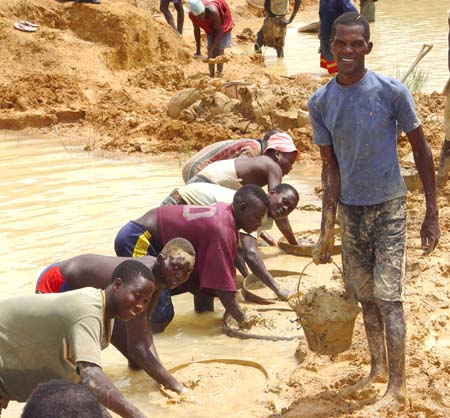 |
| Artesinal gem miners in Africa using traditional mining techniques. Photo by Laura Latrigue |
Most people think that a mine is some kind of huge excavation in the ground or a series of deep tunnels that are served by the use of large equipment including 400 ton haul trucks to bring the ore to the mill. This is hardly the kind of mine describing most colored stone operations these are artisnal in nature and have hardly changed since biblical times.
The miners use as their primary tool a conical device that resembles a gold pan with a gently sloping bottom that ends in a point. The same device is also covered with small holes following easy entrance of water. This device has many names, but at least in one country where it is still used it is called the “Batik.”
 |
| An example of a rough lavender sapphire from an alluvial deposit. Photo by Rob Lavinsky |
In use this device is filled with gem bearing gravel and then is pumped up and down in the water allowing heavier minerals to settle to the bottom of the batik. It is necessary to classify the minerals by size before being placed into the batik. Another common name for this device is the jig it because of that takes place while it is in use.
The mining takes place in the sand and gravel deposits found in association with some local stream. The gemstone deposits are usually found in close proximity to the bedrock even as gold is because most of the minerals that are classified as gemstones have a specific gravity ranging from 4 to 5 that the jigging action causes these stones to migrate to the bottom of the batik.
Sometimes the miners excavated to the gravel for 20 or more feet to reach the level of the richest deposits. Although gemstones are usually found in country that is underlain by a special type of gneiss containing the mineral cordierite like that found in the gem bearing areas of Madagascar Sri Lanka Connecticut Guilford . It is also found throughout areas that have been highly metamorphosed. It doesn't take this kind of rock to produce gemstones because they are like gold; they are where you find them.
In use once the batik has been jig up and down in the water long enough for the gemstones to settle to the bottom its top is covered with a plank and the batik is turned upside down on the plank so the gemstones are now all on top of the heap. They are then inspected for gemstones that are recovered, and the balance of the stones in the batik is discarded.
Using this method more than 50% of the colored stones that are in the jewelry trade are recovered using this method. You can make a pretty effective batik from a colander that you can buy in a kitchen supply store that is just about as effective as a batik. The most important thing that you can easily learn is what the various gemstone rough looks like.
In these times where gold is looked upon as a new measure of value it should be remembered that as far as concentrated wealth goes there is nothing that can beat gems for a very high value. Some of these gemstones are worth more than $20,000 per carat, and a caret only weighs 1/5 of a gram.
I think that people should not have so much worry so much on mining such gems, the work is hard, and dangerous. I agree, though, that the gems are beautiful.
ReplyDelete